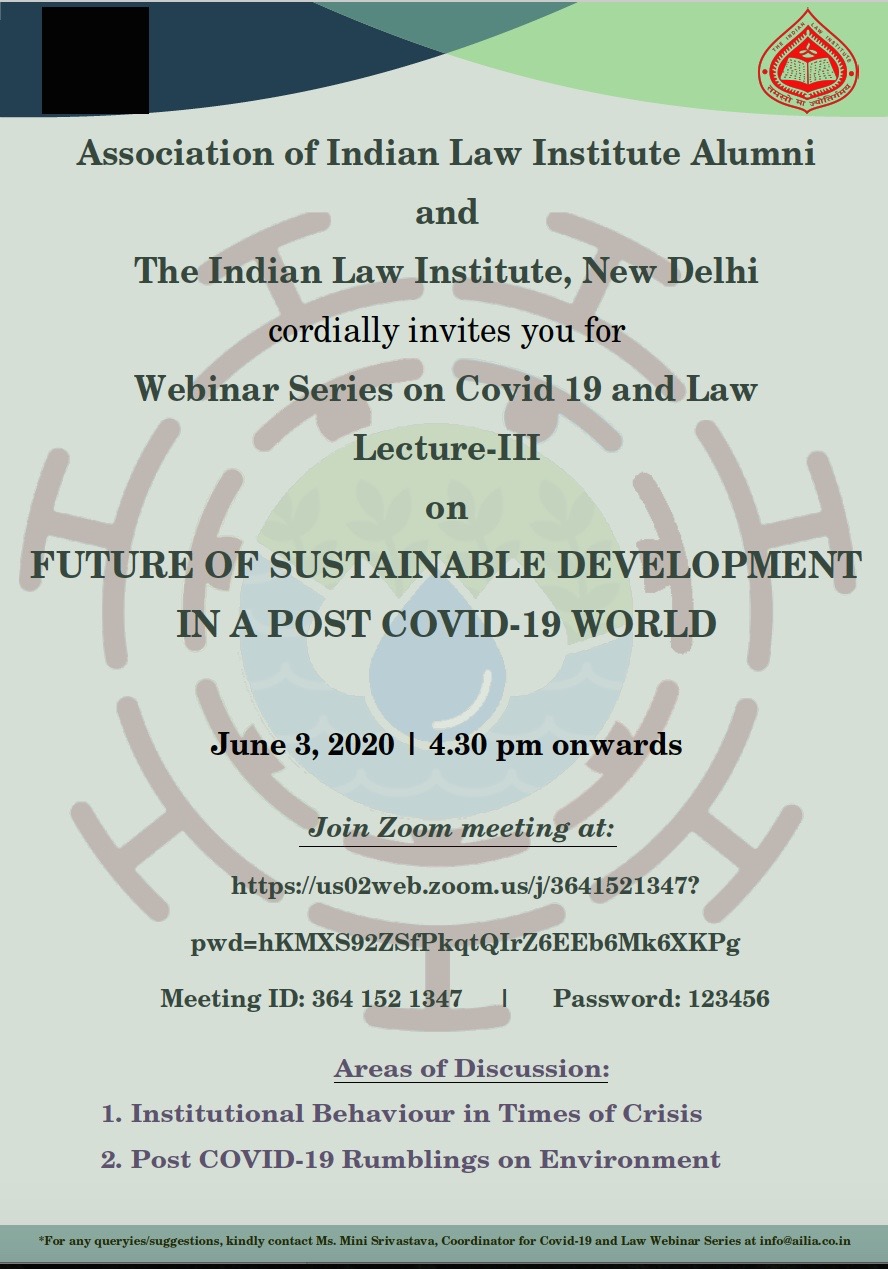Future of Sustainable Development in a Post COVID-19 World: WEBINAR
Date: 03.06.2020
Time: 16.30-18.00
Moderator: Dr Vishnu Konoorayar (HoD and Associate Professor, Centre for Postgraduate Legal Studies, TERI)
Speaker 1: Mr Sanjay Sen (Senior Advocate, Supreme Court of India)
Speaker 2: Mr Sanjay Upadhyay, (Advocate, Supreme Court of India and Managing Partner, Enviro-Legal Defence Firm)
Convenors: Ms Surabhi Pandey (Advocate and Executive Member, AILIA) Ms. Bhavna Mehrotra (Research Scholar, Faculty of Law, University of Allahabad and AILIA Representative)
Rapporteur: Mr Rupesh Chandra Madhav (Assistant professor, Lloyd Law College, Greater Noida and AILIA Representative)
BACKGROUND
- The onset and the rapid spread of COVID-19 forced governments across the world to impose partial and complete lockdown resulting in less human activity and physical interaction. Declared as a Pandemic by the WHO in the month of March, 2020, the virus has restricted the world at large to their homes, limiting most social/economic activities. With air pollution levels going down[1] , noise pollution clearly arrested and less human activity, the virus has shown the world that nature has its own ways of responding to our lackadaisical approach in treating it with dignity and respect. But there seems to be a cost attached as “COVID-19 has disrupted billions of livesand endangered the global economy. The International Monetary Fund (IMF) expects a global recession as bad as or worse than in 2009. As job losses escalate, the International Labor Organization estimates that nearly half of the global workforce is at risk of losing their livelihoods.[2]”
- With the government’s focus entirely on containing and treating the disease, its commitment towards sustainable development seems to have taken a back seat. In view of the urgent need to balance the three pillars of sustainable development viz, social, economic and environmental, the webinar aims to understand the ground realities and preparedness of the Government along with lessons for the future. It aims to give an insight into the future of sustainable development post the present crisis and the role of institutions in aiding the same.
FUTURE OF SUSTAINABLE DEVELOPMENT IN POST COVID-19 WORLD.
- The reasons for the outbreak of the virus have been attributed to factors ranging from industrialization to mass migration and deforestation[3]. There is a direct nexus between such pandemics and uncharted development. A study of the depleting Indian forest covers also sheds light on the fact that little heed is paid to the environment while promoting socio-economic development.[4] The pertinent issue here is how does a developing country like India with a population over a billion ensure sustainable development in times of such crisis also when there seems to be a consensus that we need to learn to live with the virus.
- Huge layoffs and reverse migration are causes of concern for the institutions in the present crisis, having an impact on the trinity of sustainable development. Policymakers and the machinery for their implementation have a mammoth task at hand. Another aspect that needs attention is the handling and disposal of bio-medical waste generated during and after the crisis. The government has come up with waste management norms and economic packages for various sectors but their impact is yet to come under the scanner. On the other end of the spectrum, the Draft EIA (Environmental Impact Assessment) Notification, 2020 has been put for public comments which seem to dilute the existing norms for clearance by industries.[5]
- The lockdown has put the power sector under distress as the demand for power dropped significantly, having a financial bearing mostly on the thermal power stations.[6]The the silver lining in India’s commitment towards cleaner energy and the Government’s support to the renewable sector. The GoI was also using its clean energy goals to further its objective under “Make in India”. Another glimmer of hope comes from moving towards a robust e-economy/paperless economy. Provided the power needs thereof are met with renewable sources and the electronic waste produced is handled intelligently.
- In view of the above issues and challenges, there arises the big question: How does the Government ensure sustainable development during and after the pandemic ends. What are the responses of various stakeholders/institutions and what lessons, if any can this pandemic teach us for a better future? Can the positive environmental effects be sustained post the pandemic and can this pandemic can be a watershed in human history to turn the environmental doomsday clock[7] back in time.?
- AREAS OF DISCUSSION
- Post-COVID-19 Rumblings on Environment
- Institutional Behavior in times of crises
- Environmental gains during a lockdown: Reasons and methods to sustain the same
MEETING ID
Join Zoom meeting at:
https://us02web.zoom.us/j/3641521347pwd=hKMXS92ZSfPkqtQIrZ6EEb6Mk6XKPg
Meeting ID: 364 152 1347 | Password: 123456
*For any queries/suggestions, kindly contact Ms Mini Srivastava, Coordinator for Covid-19
MEDIA PARTNER

Suggested Readings:
- https://www.carbonbrief.org/analysis-indias-co2-emissions-fall-for-first-time-in-four-decades-amid-coronavirus
- https://www.weforum.org/
- https://www.downtoearth.org.in/news/climate-change/india-s-national-action-plan-on-climate-change-needs-desperate-repair-61884
- https://www.prsindia.org/content/performance-national-action-plan-climate-change
- https://www.downtoearth.org.in/news/governance/the-environmental-cost-of-making-business-easy-59001
- https://www.undp.org/content/dam/india/docs/undp_climate_change.pdf
- https://www.teriin.org/article/right-clean-environment-has-emerged-new-human-right-india-dr-ajay-mathur
[1]Available at https://www.thehindubusinessline.com/opinion/columns/the-effect-of-covid-19-on-indias-air-quality/article31564038.ece (Last visited on 29.05.2020)
[2]Available at: https://www.un.org/sustainabledevelopment/economic-growth/ (Last visited on 29.05.200)
[3] Laura Spinney, “It takes a whole world to create a new virus, not just Chins” The Guardian, March 25, 2020.
[4] “The 2017 State of Forest report shows that it is still struggling to get above 22 per cent. India has seen rapid deforestation in recent years, primarily due to its focus on economic development. Available at: https://www.aljazeera.com/indepth/opinion/india-forests-threat-180425104442969.html (Last visited on 29.05.2020)
[5]Available at :https://www.livelaw.in/columns/the-draft-eia-notification-2020-is-a-desperate-attempt-to-dilute-the-existing-environmental-eia-regulations-156478 (Last visited on 30.05.2020)
[6] Available at: https://mercomindia.com/mnre-timely-payment-must-run-renewable-lockdown/( Last visited on 29.05.2020)
[7] The Doomsday Clock is a symbol that represents the likelihood of a man-made global catastrophe. Maintained since 1947 by the members of the Bulletin of the Atomic Scientists, The Clock represents the hypothetical global catastrophe as “midnight” and the Bulletin‘s opinion on how close the world is to a global catastrophe as a number of “minutes” to midnight, The clock is now set at 100 seconds to midnight, the closest it has ever been to symbolic doom and the first time the hands have been within the two-minute mark.













Add Comment